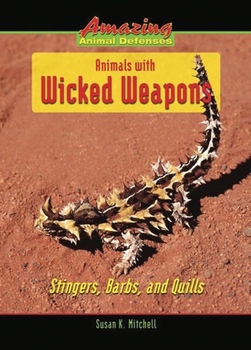
Animals with Wicked Weapons
Stingers, barbs, and quills are just some of the ways that different animals protect themselves from predators. Author Susan K. Mitchell looks at a variety of animals, from porcupines to sea urchins, to explain how animals use "weapons" to fight off predators.
* Reviews *
The six books in the Amazing Animal Defenses series (Animals with Awesome Armor: Shells, Scales, and Exoskeletons; Animals with Wicked Weapons: Stingers, Barbs and Quills; Animals with Crafty Camouflage: Hiding in Plain Sight; Animal Chemical Combat: Poisons, Smells and Slime; Animal Mimics: Look-Alikes and Copycats; and Animal Body-Part Regenerators: Growing New Heads, Tails, and Legs) do an excellent job of introducing young readers to a variety of animal defensive adaptations. Each book follows a similar outline. The first chapter describes the basic characteristics of the defensive adaptation and gives some general examples of animals that use it. Chapters 2 through 5 are "case studies" in which a particular animal that uses the defensive adaptation is described in detail. For example, in Animals with Wicked Weapons, Chapter 2 describes the porcupine, Chapter 3 the tarantula, Chapter 4 the sea urchin, and Chapter 5 the thorny devil (an Australian lizard). Each of the case studies describes the animal's natural history and how it uses its defensive adaptation. Within each of the chapters, highlighted "Wild Fact" boxes give detailed information about the animal described. Short essays interspersed throughout the main text describe other interesting examples of animals and their defensive adaptations.










